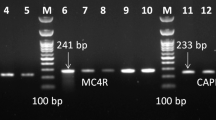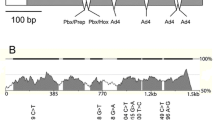Abstract
The involvement of melanocortin 4 receptor gene (MC4R) in food intake and body weight regulation is well characterized. MC4R mutations are the most frequent monogenic cause of human obesity. Significant associations have been revealed between MC4R mutations and productive traits in pigs, cattle and poultry. Herein, fluorescence-based conformation sensitive gel electrophoresis was used to identify two single nucleotide polymorphisms (SNPs) in the coding region (93G>A and 292G>A) and two SNPs in the 3′-UTR area (1016G>A and 1240T>C) of MC4R gene in 132 German Merino sheep. We found that the 1016G>A mutation in the 3′-UTR was significantly associated with body weight at 120 and 180 days, average daily gain, back fat thickness and loin-eye area. Allele A located at the 292th position of MC4R gene representing Arg98 was associated with significantly higher loin-eye area in sheep. For the synonymous 93G>A mutation, A allele carrier animals had higher back fat thickness. Our results provide evidence that the MC4R gene may be a candidate gene for growth and meat quality traits with MC4R SNPs being potentially valuable as genetic markers for economic traits in German Merino sheep.

Similar content being viewed by others
References
Gantz I, Miwa H, Konda Y, Shimoto Y, Tashiro T, Watson SJ, DelValle J, Yamada T (1993) Molecular cloning, expression, and gene localization of a fourth melanocortin receptor. J Biol Chem 268:15174–15179
Mountjoy KG, Mortrud MT, Low MJ, Simerly RB, Cone RD (1994) Localization of the melanocortin-4 receptor (MC4-R) in neuroendocrine and autonomic control circuits in the brain. Mol Endocrinol 8:1298–1308
Cone RD (2005) Anatomy and regulation of the central melanocortin system. Nat Neurosci 8:571–578
Tao YX (2010) The melanocortin-4 receptor: physiology, pharmacology, and pathophysiology. Endocr Rev 31(4):506–543
Schwartz MW, Woods SC, Porte D Jr, Seeley RJ, Baskin DG (2000) Central nervous system control of food intake. Nature 404:661–671
Parker JA, Bloom SR (2012) Hypothalamic neuropeptides and the regulation of appetite. Neuropharmacology 63:18–30
De Jonghe BC, Hayes MR, Bence KK (2011) Melanocortin control of energy balance: evidence from rodent models. Cell Mol Life Sci 68:2569–2588
Kask A, Rago L, Wikberg JES, Schioth HB (1998) Evidence for involvement of the melanocortin MC4 receptor in the effect of leptin on food intake and body weight. Eur J Pharmacol 360:15–19
Huszar D, Lynch CA, Fairchild-Huntress V, Dunmore JH, Smith FJ, Kesterson RA, Boston BA, Fang Q, Berkemeir LR, Gu W, Cone RD, Campfield LA, Lee F (1997) Targeted disruption of the melanocortin-4 receptor results in obesity in mice. Cell 88:131–141
Larsen LH, Echwald SM, Sørensen TI, Andersen T, Wulff BS, Pedersen O (2005) Prevalence of mutations and functional analyses of melanocortin 4 receptor variants identified among 750 men with juvenile-onset obesity. J Clin Endocrinol Metab 90:219–224
Vaisse C, Clement K, Guy-Grand B, Froguel P (1998) A frameshift mutation in human MC4R is associated with a dominant form of obesity. Nat Genet 20:113–114
Vaisse C, Clement K, Durand E, Hercberg S, Guy-Grand B, Froguel P (2000) Melanocortin-4 receptor mutations are a frequent and heterogeneous cause of morbid obesity. J Clin Invest 106:253–262
Buchbinder S, Bärtsch U, Müller M, Zorn M, Nawroth PP, Schilling T (2011) A novel missense mutation T101 N in the melanocortin-4 receptor gene associated with obesity. Genet Mol Res 7:1042–1049
Tao YX (2009) Mutations in melanocortin-4 receptor and human obesity. Prog Mol Biol Transl Sci 88:173–204
Tan K, Pogozheva ID, Yeo GS, Hadaschik D, Keogh JM, Haskell-Leuvano C, O’Rahilly S, Mosberg HI, Farooqi IS (2009) Functional characterization and structural modeling of obesity associated mutations in the melanocortin 4 receptor. Endocrinology 150:114–125
Kim KS, Larsen N, Short T, Plastow G, Rothschild MF (2000) A missense variant of the porcine melanocortin-4 receptor (MC4R) gene is associated with fatness, growth, and feed intake traits. Mamm Genome 11:131–135
Ovilo C, Fernández A, Rodríguez MC, Nieto M, Silió L (2006) Association of MC4R gene variants with growth, fatness, carcass composition and meat and fat quality traits in heavy pigs. Meat Sci 73:42–47
Chao Z, Wang F, Deng CY, Wei LM, Sun RP, Liu HL, Liu QW, Zheng XL (2012) Distribution and linkage disequilibrium analysis of polymorphisms of MC4R, LEP, H-FABP genes in the different populations of pigs, associated with economic traits in DIV2 line. Mol Biol Rep 39:6329–6335
Park HB, Carlborg O, Marklund S, Andersson L (2002) Melanocortin-4 receptor (MC4R) genotypes have no major effect on fatness in a Large White × Wild Boar intercross. Anim Genet 33:155–157
Fan ZC, Sartin JL, Tao YX (2008) Pharmacological analyses of two naturally occurring porcine melanocortin-4 receptor mutations in domestic pigs. Domest Anim Endocrinol 34:383–390
Qiu X, Li N, Deng X, Zhao X, Meng Q, Wang X (2006) The single nucleotide polymorphisms of chicken melanocortin-4 receptor (MC4R) gene and their association analysis with carcass traits. Sci China C Life Sci 49:560–566
Yan LJ, Fang XT, Liu Y, Zhang CL, Liu XX, Zhao J, Li JJ, Chen H (2013) Effects of single and combined genotypes of MC4R and POU1F1 genes on two production traits in Langshan chicken. Mol Biol Rep 40(7):4645–4650
Liu H, Tian W, Zan L, Wang H, Cui H (2010) Mutations of MC4R gene and its association with economic traits in Qinchuan cattle. Mol Biol Rep 7:535–540
Seong J, Suh DS, Park KD, Lee HK, Kong HS (2012) Identification and analysis of MC4R polymorphisms and their association with economic traits of Korean cattle (Hanwoo). Mol Biol Rep 39:3597–3601
Iqbal J, Pompolo S, Dumont LM, Wu CS, Mountjoy KG, Henry BA, Clarke IJ (2001) Long-term alterations in body weight do not affect the expression of melanocortin receptor-3 and -4 mRNA in the ovine hypothalamus. Neuroscience 105:931–940
Song XM, Jiang JF, Zhang GZ, Shi FX, Jiang YQ (2012) DNA polymorphisms of the Hu sheep melanocortin-4 receptor (MC4R) gene associated with birth weight and 45d-weaning weight. Genet Mol Res 11(4):4432–4441
Stephens M, Smith N, Donnelly P (2001) A new statistical method for haplotype reconstruction from population data. Am J Hum Genet 68:978–989
Stephens M, Scheet P (2005) Accounting for decay of linkage disequilibrium in haplotype inference and missing-data imputation. Am J Hum Genet 76:449–462
Barrett JC, Fry B, Maller J, Daly MJ (2005) Haploview: analysis and visualization of LD and haplotype maps. Bioinformatics 21(2):263–265
Hesketh J (2004) 3′-Untranslated regions are important in mRNA localization and translation: lessons from selenium and metallothionein. Biochem Soc Trans 32:990–993
Reamon-Buettner SM, Cho SH, Borlak J (2007) Mutations in the 3′-untranslated region of GATA4 as molecular hotspots for congenital heart disease (CHD). BMC Med Genet 8:38
Dumortier O, Van Obberghen E (2012) MicroRNAs in pancreas development. Diabetes Obes Metab 3:22–28
Shibayama A, Cook EH Jr, Feng J, Glanzmann C, Yan J, Craddock N, Jones IR, Goldman D, Heston LL, Sommer SS (2004) MECP2 structural and 3′-UTR variants in schizophrenia, autism and other psychiatric diseases: a possible association with autism. Am J Med Genet B Neuropsychiatr Genet 128:50–53
Yuan M, Zhan Q, Duan X, Song B, Zeng S, Chen X, Yang Q, Xia J (2012) A functional polymorphism at miR-491-5p binding site in the 3′-UTR of MMP-9 gene confers increased risk for atherosclerotic cerebral infarction in a Chinese population. Atherosclerosis 226(2):447–452
Kobayashi H, Ogawa Y, Shintani M, Ebihara K, Shimodahira M, Iwakura T, Hino M, Ishihara T, Ikekubo K, Kurahachi H, Nakao K (2002) A novel homozygous missense mutation of melanocortin-4 receptor (MC4R) in a Japanese woman with severe obesity. Diabetes 51:243–246
Tao YX, Segaloff DL (2003) Functional characterization of melanocortin-4 receptor mutations associated with childhood obesity. Endocrinology 144:4544–4551
Wan Y, Zhang Y, Ji P, Li Y, Xu P, Sun X (2012) Molecular characterization of CART, AgRP, and MC4R genes and their expression with fasting and re-feeding in common carp (Cyprinus carpio). Mol Biol Rep 39:2215–2223
Zhang Y, Kilroy GE, Henagan TM, Prpic-Uhing V, Richards WG, Bannon AW, Mynatt RL, Gettys TW (2005) Targeted deletion of melanocortin receptor subtypes 3 and 4, but not CART, alters nutrient partitioning and compromises behavioral and metabolic responses to leptin. FASEB J 19:1482–1491
Wagner CG, McMahon CD, Marks DL, Daniel JA, Steele B, Sartin JL (2004) A role for agouti-related protein in appetite regulation in a species with continuous nutrient delivery. Neuroendocrinology 80:210–218
Sartin JL, Wagner CG, Marks DL, Daniels J, McMahon CD, Obese FY, Partridge C (2005) Melanocortin-4 receptor in sheep: a potential site for therapeutic intervention in disease models. Domest Anim Endocrinol 29:446–455
Komar AA (2007) Silent SNPs: impact on gene function and phenotype. Pharmacogenomics 2007(8):1075–1080
Chen R, Davydov EV, Sirota M, Butte AJ (2010) Non-synonymous and synonymous coding snps show similar likelihood and effect size of human disease association. PLoS One 5(10):e13574. doi:10.1371/journal.pone.0013574
Hunt R, Sauna ZE, Ambudkar SV, Gottesman MM, Kimchi-Sarfaty C (2009) Silent (synonymous) SNPs: should we care about them? Methods Mol Biol 578:23–39
Acknowledgments
This work was was financially supported by the National Meat-type Sheep and Goat Industrial Technology System (CARS-39-1A). The kind cooperation of the workers in sampling is greatly acknowledged.
Author information
Authors and Affiliations
Corresponding author
Rights and permissions
About this article
Cite this article
Zuo, B., Liu, G., Peng, Y. et al. Melanocortin-4 receptor (MC4R) polymorphisms are associated with growth and meat quality traits in sheep. Mol Biol Rep 41, 6967–6974 (2014). https://doi.org/10.1007/s11033-014-3583-x
Received:
Accepted:
Published:
Issue Date:
DOI: https://doi.org/10.1007/s11033-014-3583-x




